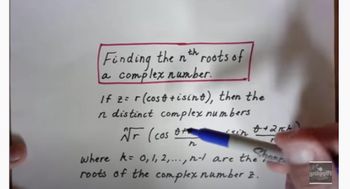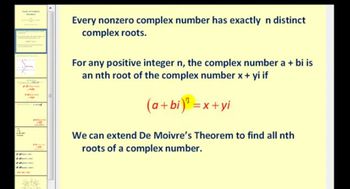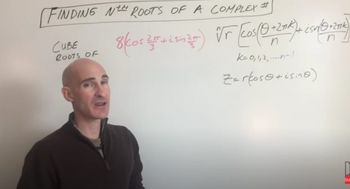Table of contents
- 0. Review of College Algebra4h 43m
- 1. Measuring Angles39m
- 2. Trigonometric Functions on Right Triangles2h 5m
- 3. Unit Circle1h 19m
- 4. Graphing Trigonometric Functions1h 19m
- 5. Inverse Trigonometric Functions and Basic Trigonometric Equations1h 41m
- 6. Trigonometric Identities and More Equations2h 34m
- 7. Non-Right Triangles1h 38m
- 8. Vectors2h 25m
- 9. Polar Equations2h 5m
- 10. Parametric Equations1h 6m
- 11. Graphing Complex Numbers1h 7m
11. Graphing Complex Numbers
Powers of Complex Numbers (DeMoivre's Theorem)
Problem 67
Textbook Question
In Exercises 65–68, find all the complex roots. Write roots in polar form with θ in degrees. The complex cube roots of 8(cos 210° + i sin 210°)
 Verified step by step guidance
Verified step by step guidance1
<insert step 1> Convert the given complex number into polar form. The given complex number is already in polar form as 8(cos 210° + i sin 210°), where the modulus is 8 and the argument is 210°.
<insert step 2> Use De Moivre's Theorem to find the cube roots. According to De Moivre's Theorem, the nth roots of a complex number with modulus r and argument θ are given by: r^{1/n} (cos((θ + 360°k)/n) + i sin((θ + 360°k)/n)), where k = 0, 1, ..., n-1.
<insert step 3> Calculate the modulus of the cube roots. Since the original modulus is 8, the modulus of each cube root is 8^{1/3}.
<insert step 4> Calculate the arguments for each of the three cube roots. Substitute n = 3 and k = 0, 1, 2 into the formula: (210° + 360°k)/3.
<insert step 5> Write each of the three cube roots in polar form using the calculated modulus and arguments.>
Recommended similar problem, with video answer:
 Verified Solution
Verified SolutionThis video solution was recommended by our tutors as helpful for the problem above
Video duration:
4mPlay a video:
Was this helpful?
Key Concepts
Here are the essential concepts you must grasp in order to answer the question correctly.
Complex Numbers
Complex numbers are numbers that have a real part and an imaginary part, expressed in the form a + bi, where 'a' is the real part and 'b' is the imaginary part. In trigonometric form, a complex number can be represented as r(cos θ + i sin θ), where r is the modulus and θ is the argument. Understanding complex numbers is essential for finding roots and performing operations in the complex plane.
Recommended video:

Dividing Complex Numbers
De Moivre's Theorem
De Moivre's Theorem states that for any complex number in polar form r(cos θ + i sin θ) and any integer n, the nth power of the complex number can be expressed as r^n(cos(nθ) + i sin(nθ)). This theorem is also used to find the nth roots of complex numbers, which involves dividing the angle by n and taking the nth root of the modulus, making it crucial for solving the given problem.
Recommended video:

Powers Of Complex Numbers In Polar Form (DeMoivre's Theorem)
Polar Coordinates
Polar coordinates represent points in the plane using a distance from the origin (r) and an angle (θ) from the positive x-axis. In the context of complex numbers, this representation simplifies multiplication and division, as well as finding roots. When converting complex numbers to polar form, understanding how to manipulate angles and magnitudes is key to accurately determining the roots.
Recommended video:

Intro to Polar Coordinates

 3:41m
3:41mWatch next
Master Powers Of Complex Numbers In Polar Form (DeMoivre's Theorem) with a bite sized video explanation from Nick Kaneko
Start learningRelated Videos
Related Practice











